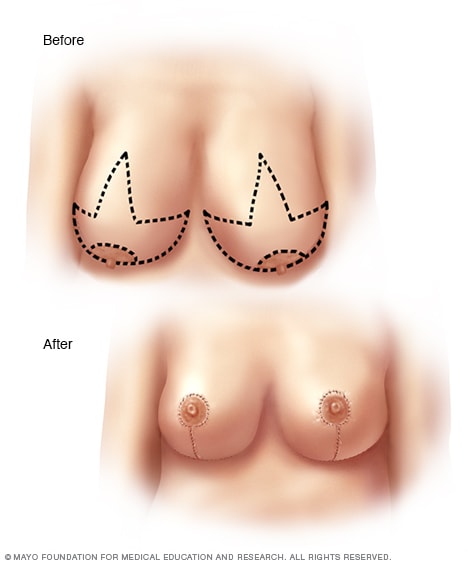Overview
Breast reduction surgery, also known as reduction mammaplasty, removes fat, breast tissue and skin from the breasts. For those with large breasts, breast reduction surgery can ease discomfort and improve appearance.
Breast reduction surgery might also help improve self-image and the ability to take part in physical activities.
If you're thinking of breast reduction surgery, talk to a board-certified plastic surgeon. It's important to understand what's involved with breast reduction surgery, including possible risks and complications. It's also important to know what the surgery can and can't do.
Products & Services
Why it's done
Breast reduction surgery is meant for people who have large breasts that cause the following:
- Chronic back, neck and shoulder pain
- Shoulder grooves from bra straps
- Chronic rash or skin irritation under the breasts
- Nerve pain
- Not being able to take part in some activities
- Poor self-image due to large breasts
- Trouble fitting into bras and clothing
Breast reduction surgery generally isn't recommended for people who:
- Smoke
- Are very obese
- Don't want scars on the breasts
You can have breast reduction surgery at any age — sometimes even as a teenager. But breasts that aren't yet fully grown might need a second surgery later in life.
Reasons to postpone breast reduction surgery include:
- Planning to have children. Breastfeeding might be challenging after breast reduction surgery. However, certain surgical techniques can help keep the ability to breastfeed.
- Planning to lose weight. Losing weight can often result in changes to breast size.
Risks
Breast reduction surgery has the same risks as other major surgeries — bleeding, infection and a bad reaction to the anesthesia. Other possible risks include:
- Bruising, which is temporary
- Scarring
- Difficulty or inability to breastfeed
- Differences in the size, shape, and look of the left and right breasts
- Not being happy with the results
- Rarely, losing the nipples and skin around the nipples or the feeling in them
How you prepare
Your plastic surgeon will likely:
- Look at your medical history and overall health
- Discuss what size you want your breasts to be and how you want them to look after the surgery
- Describe the surgery and its risks and benefits, including likely scarring and possible loss of feeling
- Examine and measure your breasts
- Take photographs of your breasts for your medical record
- Explain the type of medicine used to put you to sleep during surgery
Planning breast reduction surgery might require:
- A mammogram
- Not smoking for at least six weeks before and after surgery
- Not taking aspirin, anti-inflammatory drugs and herbal supplements, to control bleeding during surgery
Usually, you can go home the day of the surgery. Arrange for someone to drive you home from the hospital.
What you can expect
Breast reduction surgery is usually done under general anesthesia, either in a hospital or outpatient surgical center.
During the procedure
Incisions made for breast reduction surgery

Incisions made for breast reduction surgery
The typical anchor-shaped incision in breast reduction surgery allows the surgeon to remove excess breast tissue, fat and skin and raise the nipple and areola, as shown on top. After the excess tissue is removed, the surgeon brings the skin underneath the breast together with stitches, as shown at bottom.
The method used to reduce the size of your breasts can vary. The process might include:
- Surgery through incisions
- Liposuction to remove excess fat in the breasts
The surgeon usually:
- Makes an incision around the nipple and areola and down each breast
- Removes excess breast tissue, fat and skin to reduce the size of each breast
- Reshapes the breast and resets the nipple and area around it, also known as the areola
The nipple and the area around it usually stay attached to the breast. For very large breasts, the surgeon might need to remove them and add on a new nipple.
Your surgeon will try to make your breasts look alike, but breast size and shape might vary somewhat. The size of the areola also might be smaller. The incision scars will fade over time, but they won't completely go away.
After the procedure
Immediately after surgery:
- The breasts are covered with bandages and a surgical bra to hold them in place
- A tube might be placed under each arm to drain any extra blood or fluid
- You may receive medicine for pain and medicine to decrease the risk of infection
For the first days or week after surgery:
- The breasts will probably feel tender
- The breasts might be swollen and bruised
- A surgical bra that closes in front is worn to support the breasts
After that:
- Limit physical activity for 4 to 6 weeks while the breasts heal
- Wear an approved surgical bra at all times to allow the breasts to heal and reduce swelling
Scarring fades over time. You will need a follow-up visit with your surgeon to check your recovery.
Results
Successful breast reduction surgery can relieve pain in the upper back, neck and shoulders. It might also increase the ability to take part in physical activities and promote a better self-image.
Results will show right away, but it can take months for the swelling to completely go down and the surgical scars to fade. The final result generally lasts a long time. But aging, changes in weight, pregnancy and other factors can change breast shape and size.
Clinical trials
Explore Mayo Clinic studies of tests and procedures to help prevent, detect, treat or manage conditions.